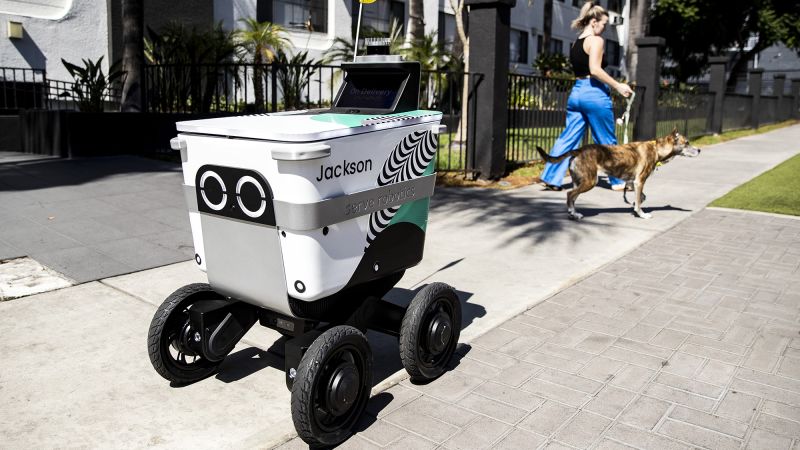
Its name is Courtney.
Courtney doesn’t have eyes, but it’s got sensors everywhere. There are two blinking lights on the front of its boxy body to approximate wide, moony pupils. It’s been described as a “large cooler on four wheels.”
Courtney is a food delivery robot from Serve Robotics, transporting Uber Eats orders typically when there’s a mile or less between a restaurant and a customer. Courtney showed up in my Atlanta neighborhood one day toward the end of June with dozens of other four-wheeled bots with names like Deandre and Orion.
Courtney and the bots have had some trouble navigating Atlanta. They get confused at crosswalks. They move with the speed and caution of a first-time driver, stilted and shy, until they suddenly speed up without warning. Their four wheels look like they were made for off-roading, but they still get stuck in the cracks of craggy sidewalks. Most times I see the bots, they aren’t moving at all.
When they first got here, they were objects of curiosity. People took pictures of them and made TikToks when they spotted them on the street for the first time — the future is now!
Three months after their arrival, though, the novelty has worn off. They’re not photo ops anymore. Cyclists swerve to avoid them like any other obstacle in the road. Patrons of Shake Shack (a national partner of Serve) weave around the mess of robots parked in front of the restaurant to make their way inside and place orders on iPads. They’re as much an accepted part of life in my neighborhood as the obnoxious scooters that litter sidewalks.
“I think folks are always asking, ‘When are robots finally here?’ They really are finally here,” Serve Robotics CEO Ali Kashani told me. “If you’re lucky to live in one of these cities, you see it today. If not, probably in a couple of years, it will be something that everybody will have seen in their environment.”
The dawn of everyday, “friendly” robots may be here, but they haven’t proven themselves useful — or trustworthy — yet.
“People think they are your friends, but they’re actually cameras and microphones of corporations,” said Joanna Bryson, a longtime AI scholar and professor of ethics and technology at the Hertie School in Berlin. “You’re right to be nervous.”
Skepticism is warranted
Edward Ongweso Jr. is a researcher at the Security in Context initiative, a tech journalist and a self-proclaimed “decel.” (That’s short for “decelerationist,” or someone who thinks Silicon Valley tech pioneers need to slow their roll, as do the leaders who quickly embrace untested and unregulated technology.) He told me skepticism toward new technology is healthy. Phew.
When robots show up in a city, it’s often not because the residents of said city actively wanted them there or had a say in their arrival, he said.
“They’re being rolled out without any sort of input from people, and as a result, in ways that are annoying and inconvenient,” Ongweso Jr. said. “I suspect that people would feel a lot differently if they had a choice … ‘what kind of robots are we interested in rolling out in our homes, in our workplaces, on our college campuses or in our communities?’”
Delivery robots aren’t unique to Atlanta. AI-driven companies including Avride and Coco Robotics have sent fleets of delivery robots to big cities like Chicago, Dallas and Jersey City, as well as sleepy college towns. Uber and Lyft now offer self-driving cars — in my city, driverless Waymos are so popular that people are canceling rides until they’re paired with an autonomous vehicle, per Business Insider.
“They’re popping up everywhere,” Ongweso Jr. continued, “because there’s sort of a realization that you have to convince people to view them as inevitable. The way to do that is to just push it into as many places as possible, and have these spectacle demonstrations, get some friendly coverage, try to figure out the ways in which you’re selling this as the only alternative.”
The robots have gotten plenty of uncritical coverage since arriving in Atlanta They are also on Netflix: On “Everybody’s Live with John Mulaney,” the comedian cast a Serve robot named Saymo as a foil to sidekick Richard Kind. (Kashani assures me that the robot that was destroyed during an Evel Knievel-style jump was fake; the real robot was unscathed.) They’ve even been used as literal vehicles for activism: In 2023, Serve introduced rainbow-painted robot Marsha, named for trans rights activist Marsha P. Johnson.
I asked Kashani whether the bots have cute names and fake LED peepers to endear them to people and hopefully make them less kickable. If a silly moniker like Clifford and a paint job from a local artist protect a robot from abuse, that’s an upside, but it’s not the point, he said.
“We want the robots to be friendly and fun and embraced by the communities they go to,” he said. “But also, why not have some fun? We’re making robots. This has been a dream for humanity for like, four to five decades. It’s a wasted opportunity not to have fun.”
But the bots are products, first and foremost, not friends, Ongweso Jr. said. The success of Courtney and Deandre and the rest makes investors money.
“If you humanize it, you’re more willing to entertain it and rationalize it being in your area — ‘That’s just Jeffrey,’ or whatever they name it — instead of seeing it for what it is, which is a bunch of investors privately encroaching on a community or workplace,” Ongweso Jr. said. “It’s not the future. It’s a business model.”
I tried to order from a bot — 12 times
To give the bots the benefit of the doubt, I tried to employ them.
I ordered delivery from Uber Eats one dozen times in two months, each time from restaurants I easily could’ve walked to but didn’t in hopes that Courtney or Deandre or a compatriot would pick up my food instead. They never came, but very efficient human cyclists did, typically in 15 minutes or less. I live about one-third of a mile away from the hub where many of the four-wheelers hang out, but I still haven’t scored a robot courier.
It’s hard to know how successful these bot deliveries are when they’re almost never seen in motion.
“They’re betting that, since this is a convenience thing, this is a luxury service, you can provide something that maybe is worse than what a human would provide, but because you’re still getting your new treat, you’re fine with it,” Ongweso Jr. posited.
Serve launched its robots in Atlanta in an attempt to reduce traffic in a city where most residents use cars to get around, Kashani told me. Its robots’ average delivery distance in the city is under a mile, and it takes them about 18 minutes to make their deliveries, according to Serve. They’re supposed to do fine in extreme heat and snow, though residents of other cities have had to rescue them when they’ve been felled by weather.
“They’re going to make cities safer, reduce emissions, help merchants make delivery more accessible to more folks,” Kashani said.
Robot delivery is also likely cheaper for consumers for one crucial reason, he said: “You don’t have to tip the robots.”
But Serve launched its first fleets in Atlanta’s most walkable neighborhoods, where there are dozens of restaurants within walking distance of an estimated 50,000 residents. These neighborhoods are also among the wealthiest in Atlanta. Do we really need bots here?
Was I overthinking the bot hate?
After a few weeks of ranting against the bots to friends, coworkers and sources, I started to wonder whether my loathing was misplaced. Perhaps I should aim my ire at more immediately nefarious forms of AI, like ChatGPT, whose potential to harm people is already well-documented, or at companies like Uber, who don’t have to pay as many employees if there are robots who work for free doing their jobs.
Dylan Losey, an assistant professor of mechanical engineering at Virginia Tech who studies human-robot interaction, said there’s nothing inherently wrong with delivery robots.
“If we can create robots that do a boring, repetitive task for humans — like delivering food — then I think we’re moving in the right direction,” he wrote in an email. “However, I am skeptical about how these robots interact with people.”
What troubles him, he said, is that the AI algorithms that run these robots are “completely unregulated.”
“We don’t know if a third party has checked the hardware and software and deemed the system ‘safe’ — in part because what it means for these systems to be ‘safe’ is not fully understood or standardized,” Losey said. “The people who interact with delivery robots are basically put in a position where they have to trust that the robots are built and programmed with our best interests at heart.”
One last delivery
I made one final attempt to court a bot courier toward the end of September when I came across 10 of them parked outside Shake Shack, no longer completely obstructing the entrance. Dallas and Clyde had their “on delivery” flags up; Deirdre was advertising the latest “Sonic the Hedgehog” sequel. Surely, ordering right next to them, from Shake Shack, would work this time.
I sat six feet away from the small army of bots for 20 minutes and none of them moved to deliver, for me or for anyone. I adjusted my delivery location to the very spot where I sat. I even tried setting the tip to $0, which should improve one’s chances of scoring a bot deliverer, but that only made it more difficult to convince a human to pick up an order I immediately regretted placing. (I couldn’t set a tip for my human driver again until after those sad cheese fries arrived.)
The bots are more annoying than directly harmful, I recognize, though they caused an uproar elsewhere last month: In Los Angeles, one of the first major cities where Serve robots deployed, a man with cerebral palsy filmed a bot repeatedly swerving in his path and blocking the sidewalk, eventually resulting in a collision with his mobility scooter.
I’ve identified my fear of these ostensibly harmless bots: As the use of this technology spreads, will we depend more on robots than people — and what will become of the people whose livelihoods are affected by our antisocial practices? Will AI become so ingrained in the ways we think, create, communicate and live that it’ll be impossible to extricate ourselves from it. AI is even being tested in military operations. And yet, for all its potentially sinister uses, I’m more worried about what it’ll turn us into.



